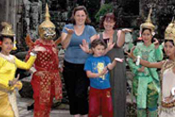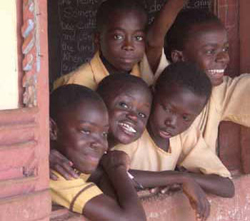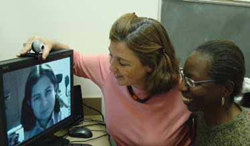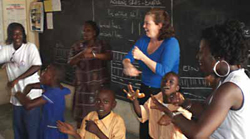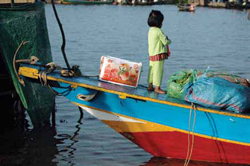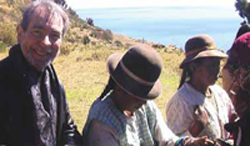Giving Voice to the World
In seeding their profession in some of the world's poorest countries, speech and language pathologists from TC are also building a multilingual base in the United States
In Ghana , a country roughly the size of Oregon
“One of the special education teachers we worked with there this past February was pregnant, and people were saying to her and her husband, ‘You should keep away from those children,’” says Catherine Crowley, Distinguished Lecturer and Coordinator of the Bilingual/Bicultural Program focus in TC’s Speech and Language Pathology (SLP) program. “So when her baby was born, people filed into her home to see if she was normal, and they couldn’t believe it when she was.”
Crowley and the bilingual/bicultural staff and students have faced many similar cultural challenges during the past several years as they have sought to work with speech-impaired children in developing nations around the world. The aim of their efforts, which have included work in Ghana, Bolivia and Cambodia, is threefold: to seed their profession in countries where it is either almost wholly lacking or its practitioners are inaccessible to average people; to build up existing structures or leave sustainable gains wherever they can; and, longer term, to increase the number of bilingual speech/language pathologists in the United States, particularly to serve the country’s booming Latino population.
“Communication obviously is essential to the whole learning process, whether in a classroom or for a single human being, and we’ve made a commitment to the multilingual and multicultural aspects of communications and its disorders,” says John Saxman, Professor of Speech Pathology and Chair of TC’s Department of Biobehavioral Sciences. “If children have disorders of speech and language, then they need someone working with them who has an understanding of what the bilingual situation is and can separate out those problems that may simply be a function of learning two languages and using them simultaneously, from something that may be an actual disorder of speech and language.”
Until recently, much of that work was conducted in New York City at Teachers College’s Edward D. Mysak Speech, Language and Hearing Center Crowley began taking groups of students down to Bolivia Crowley , clinical coordinator Miriam Baigorri and others, the students work at the Hospital Del Niños, which is Bolivia
At Hospital Del Niños, the TC students work with children in the acute care wards and with parents of babies and toddlers who are failing to thrive, showing them feeding therapy and early intervention stimulation techniques such as cooing, eye contact and touching. At Fundacion CEREFE in El Alto, they work with children and teenagers with disabilities ranging from Down’s syndrome to swallowing disorders. And at Camino De Sordos, the TC students provide children with hearing aids secured by TC alumna Melissa Inniss, a Panamanian audiologist and speech/language pathologist, and apply a multisensory approach to help children identify and use phonemes, the smallest sound units that differentiate meaning, as they learn to read.
Before the TC team arrived, the school was focusing on non-academic exercises. “We were able to bring in the idea that people with disabilities have the right to learn and the ability to learn,” Crowley
The group has left other lasting impressions, as well. As part of their work in Bolivia Crowley
Thanks to technology, the program has even developed a way to work from afar with the students in La Paz
The half-hour sessions, conducted via Skype technology in what Crowley believes is the first such opportunity provided to graduate students in the United States
“One teenager told us how he had had hearing aids when he was a young boy but did not use them because he could not make sense out of the sounds,” Crowley
Each year when they return from Bolivia , Crowley
Crowley’s team first established its
“There’s a huge influx of people from Africa , and there’s maybe less than a handful of speech/language pathologists who are bilingual in any of the African languages,” she says. “When these kids come, they need services.”
During their 2009 stay in Ghana , Crowley Kumasi
“He told us, ‘I have people with cancer, and I remove their larynx and there’s no speech, and I leave them without a voice,’” Crowley
In fact, Crowley Crowley
And then there is Cambodia , where Crowley
The two worked with young patients and their parents at the National Pediatric Hospital in Phnom Penh , where, among other encounters, Froud—who has a long-standing association with Cambodia —discovered that doctors there did not have sufficient expertise to make good use of a 36-channel electroencephalogram (EEG) machine donated from Korea Angkor Hospital Cambodia
In Siem Reap City, where Handicap International provides prostheses and rehabilitation for people who have lost limbs in land mine incidents, Froud and Crowley met a two-year-old boy with cerebral palsy, who sat hunched over, with his gaze permanently fixed on the floor due to poor muscle tone. By showing his mother how to hold his head, change his posture, and use some stimulating materials, they were very quickly able to engage his attention so that he was reaching out to turn the pages by himself. To provide the boy’s mother the means to help him learn obviously was a huge benefit to the child; to witness the sharing of medical expertise across cultures would, Froud and Crowley believe, be of almost equal benefit to a student seeking to work with multicultural populations.
“If you want to really know how to work in a culturally sensitive way, you’ve got to go outside your own culture,” says Crowley , who traces her interest in international work to a college semester spent in Mexico
Published Monday, Jun. 15, 2009
